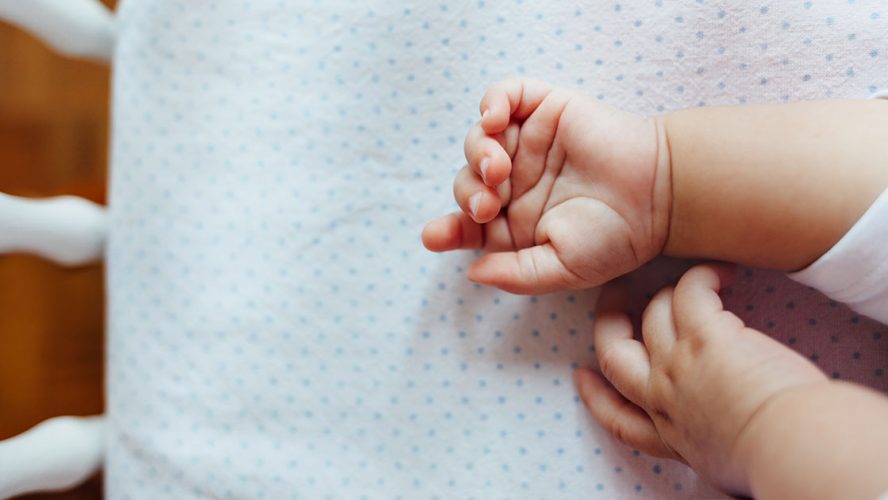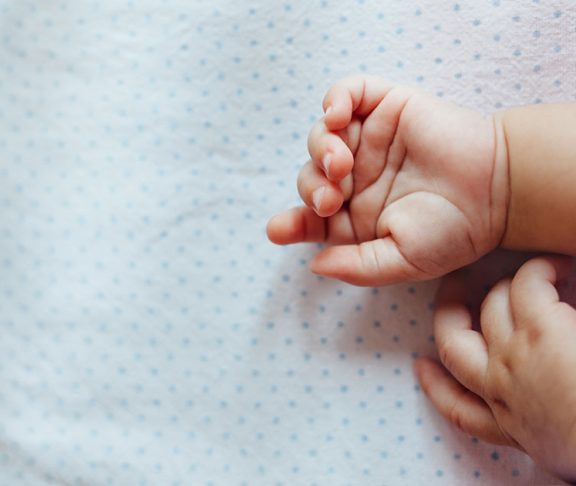The American Academy of Pediatrics (AAP) recently updated its guidelines on safe sleep and offers the following recommendations on how to create a safe sleep environment for your baby. Keep in mind that these recommendations, unless noted otherwise, are for babies up to one year of age. If you have any questions about these recommendations or about the health of your baby, please talk with your pediatrician.
1. Get back to sleep
Babies should sleep on their backs for all sleep times — for naps & at night — until their first birthday. This is because babies who sleep on their backs are much less likely to die of sudden infant death syndrome (SIDS) than babies who sleep on their stomachs or sides. Some parents worry that babies will choke when on their backs, but the baby’s airway anatomy and the gag reflex will keep that from happening.
Some babies will roll onto their stomachs. While you should always place your baby to sleep on their back, if your baby is comfortable rolling both ways (back to tummy, tummy to back), then you do not have to return your baby to the back. If your baby falls asleep in a car seat, stroller, swing, infant carrier or sling, move them to a firm sleep surface on their back as soon as possible.
2. Use a firm sleep surface
Only use a crib, bassinet, portable crib or play yard that meets the safety standards of the Consumer Product Safety Commission (CPSC) along with a tight-fitting, firm mattress and fitted sheet. Nothing else should be in the crib except for the baby. While bedside sleepers are available, there are no published studies that have examined the safety of these products. In addition, some crib mattresses and sleep surfaces are advertised to reduce the risk of SIDS. There is no evidence that this is true, but parents can use these products if they meet CPSC safety standards.
3. Share the room
Keep your baby’s sleep area in the same room where you sleep for the first 6 months or, ideally, for the first year. The AAP recommends room sharing because it can decrease the risk of SIDS by as much as 50 percent and is much safer than bed sharing. In addition, room sharing will make it easier for you to feed, comfort and watch your baby.
4. Keep your distance
Only bring your baby into your bed to feed or comfort.If there is any possibility that you might fall asleep, make sure there are no pillows, sheets, blankets or any other items that could cover your baby’s face, head and neck or that could overheat your baby. As soon as you wake up, be sure to move the baby to their own bed.
5. Don’t change it up
Never place your baby to sleep on a couch, sofa or armchair. This is an extremely dangerous place for your baby to sleep.
6. Don’t share with newborns
Bed sharing is not recommended for any babies. However, certain situations make bed sharing even more dangerous. Do not bed share with your baby if they’re younger than 4 months old, your baby was born prematurely or with low birth weight, you or any other person in the bed is a smoker (even if you do not smoke in bed), the mother of the baby smoked during pregnancy, you have taken any medicines or drugs that might make it harder for you to wake up, you drank any alcohol, you are not the baby’s parent or if there is soft bedding like pillows or blankets on the bed.
7. Clear the space
The following objects could increase the risk of entrapment, suffocation or strangulation and should be kept out of your baby’s sleep area:pillows, quilts, comforters, sheepskins, blankets, toys, bumper pads or similar products that attach to crib slats or sides. If you are worried about your baby getting cold, use infant sleep clothing, such as a wearable blanket. A good rule of thumb is to dress your baby with only one more layer than you are wearing.
8. Don’t wrap them too tight
It is fine to swaddle your baby. However, make sure your baby is always on their back when swaddled. The swaddle should not be too tight or make it hard for your baby to breathe or move their hips. When your baby looks like he or she is trying to roll over, you should stop swaddling.
9. Experiment with the pacifier
Try giving them a pacifier at nap time and bedtime. This helps reduce the risk of SIDS, even if it falls out after the baby is asleep (and if it falls out, you don’t need to put it back in). If you are breastfeeding, wait until breastfeeding is going well before offering a pacifier. This usually takes 2-3 weeks.
More than 3,500 babies in the United States die suddenly and unexpectedly every year while sleeping, often due to sudden infant death syndrome (SIDS) or accidental deaths from suffocation or strangulation. These guidelines were developed to help prevent these unnecessary deaths because all children deserve to be healthy.

